Cells that are round have the following morphology:
Coccus
Cells that are rectangular in shape have the following morphology:
Bacillus
Long thing flexible cells shaped like a corkscrew, containing axial filaments, have the following morphology:
spirochete
Two round cells that are physically stuck together have teh following arrangement:
diplococcus
several rectangular cells that form a chain have the following arrangement:
Streptobacillus
Cells shaped like a comma have the following morphology:
Vibrio
A simple staining employs the use of a ___ charged dye to stain cells that are ___ charged:
Positively, Negatively
True/False:
The purpose of a heat-fixation is to kill the organisms, they will adhere to the slide, and it will stimulate motility by activating flagella
False
Smears should never be heat-fixed while they are still wet because
creates living aerosols
True/False:
Simple staining is not very useful for examining living organisms or for testing an organisms' motility.
True
True/False:
When performing negative staining, it is important to heat fix the microbial smear prior to staining.
False
Cells that are wavy, large, and rigid, with external flagella, have the following morphology:
Spirillum
After performing a negative stain, for the most part, how will the cells look?
colorless
Four or more bacilli shaped cells that are arranged in a long chain:
Streptobacillus
Multiple Choice:
Living cells have a net (negative OR positive) charge and will (attract OR repel) negatively charge stains.
Negative, Repel
True/False:
Gram negative cells have a thick cell wall and are surrounded by an additional layer of lipid.
False
When Gram-negative cells lyce in KOH test, what cellular material causes the characteristic "stringing"?
Chromosomal DNA
In the Gram stain, the primary stain is:
Crystal Violet
If the iodine step is missed, Gram positive cells will appear ___ at the completion of the protocol:
Red
True/False:
Gram-positive cells are susceptible to Vancomycin while most Gram-negative cells are resistance.
True
Bacterial cells that are actively undergoing metabolic processes and binary fission are referred to as:
Vegetative
the two clinically significant genera that are capable of producing endospores:
Bacillus, Clostridium
Why is steam used during endospore staining?
Heat i necessary for driving stain into the spore coat
In the capsule stain, what stain serves as the negative stain?
Congo Red
In the capsule stain, what stain serves as the positive stain?
Maneval's
Four chemical elements essential for comprising 98% all living things:
Carbon (C), Hydrogen (H), Oxygen (O) and Nitrogen (N)
- Phosphorus (P) and Sulfur (S) are also necessary
What are the optimum temperatures at which all living organisms grow?
Body temperature 37*C
Room temperature 20-27*C
Refrigerator temperature 4-10*C
Freezer temperature -20*C
Note: Some microbes grow above or below these temperatures
Members of Microbial world
Living Members:
Nonliving Members:
Living: bacteria, protozoa, fungi, algae, and parasitic worms
Nonliving: viruses, viroids, and prions
Media (singular: Medium)
the food that is used to culture microorganisms
Physical Factors that affect Growth of Microorganisms:
1. Temperature - there is an optimum temperature for all living organisms to grow
2. pH - reflects the relative acidity/alkalinity of a solution (0
[most acidic] to 14 [most alkaline]) all living organisms have an
optimum pH
- Human Blood has a pH of 7.2-7.4
3. Oxygen gas: only 50% of all microorganisms require oxygen
-
In fact, even trace amounts of oxygen can be deadly to some microbes
4. Salt concentration: Controls the amount of water available to a cell (also the same with sugar)
Isotonic
Define: Solute concentration is the same outside & inside the cell
What happens: Stays the same
Why: Equilibrium already reached
Hypertonic
Define: Solute concentration greater outside the cell than inside the cell
What happens: Crenates (shrinks)
Why: water rushes out of the cell
Hypotonic
Define: Solute concentration less outside the cell than inside
What happens: Lysis (swells)
Why: water rushes into the cell
Types of media
1. Solid: Agar
2. Liquid: Broth
3. Semisolid: contains lower % of agar than solid media (bit runny)
Agar
an algal extract that acts as a solidifying ingredient when added to microbial media
- no nutritional substance
the media is mixed , heated to boiling, & sterilized into an autoclave. Once sterile, molten media is put into sterile Petri dishes or test tubes.
Why not use gelatin instead of agar?
Gelatinized media turns to a liquid at 37* (room temperature) and agar does not. Aldo some organisms produce enzymes that turn gelatin into a liquid.
Most bacteria divide by a process called...
Binary fission
- Binary - 2
- Fision - to split
Generation time
the time it takes for a single cell to split into two new cells
When you start to see one little colony approximately how many cells need to be in the colony for you to be able to "see" it?
About 1 million
Descriptive terms for colonies grown on a solid surface
1. Whole colony shape
2.Margin (edge of the colony):
Swarm - leaving an opaque pattern of waves across
the medium (sometimes they do this)
3. Elevations: What the
colony looks like from the side (how high off media
4. Size:
measured in millimeter (mm) Punctiform- colonies of
enormous size
5.Texture: wet, mucoid, erose (dry, crusty)
granular, opaque (almost see through them), shiny, and dull
6.
Pigment: may be within the colony or diffusing away from the colony
NA Agar
Bacterial
SDA agar
Fungal
Bacterial Configurations:
1 Round,
2 Round with scalloped margin,
3 Round with
raised margin,
4 Wrinkled,
5 Concentric,
6 Irregular
and spreding
Fungal Configurations
1 Filamentous,
2 L-Form (darker mass in middle)
3 Round
with radiating margin
4 Filiform
5 Rhiziod
6 Complex
Bacterial Margins:
1. Smooth (entire)
2. Wavy (undulated)
3. Lobate
4.
Irregular (erose)
Fungal Margins:
1. Ciliate
2. Branching
3. Wooly
4. Thread-like
5."Hair-Lock"-like
Bacterial Elevations:
1. flat
2. raised
3. convex
4. Drop-like
(5.) Umbonate ??
Fungal Elevations:
1. Hilly
2. Ingrowing into medium
3. Crateriform
(4.) Umbonate ??
Ring
Film of growth clinging to the test tube at the liquid-air interface
Pellicle
A membrane or scum-like structure that floats on the top of the liquid media
Sediment
Organisms may settle and grow, forming a layer at the bottom of the tube.
Folcculent
Visible chunks/flakes/broken particles supended throughout the broth medium
Uniform Fine Tubridity
Turbidity means "cloudy"
Why might an organism fail to grow?
bad culture, loop was too hot when trying to transfer, or the nutrients weren't right for the the organism
Why might two different organisms show exactly the same growth features even if they are not supposed to?
Cross contamination
Why is it necessary to use a negative control?
It make it easier for a base-line comparison
What is meniscus?
When water beads or pools up on a surface
what growth patterns are similar or different among the organisms tested?
Bacillus subtilius - Pellicle (the only one that had it)
Everything had sediment
Is it possible for an organism to produce more than one growth pattern in the same tube?
Yes
A film of growth on teh surface:
Pellicle
Even cloudiness
Uniform fine turbidity
Growth adhering to the glass at the liquid/air interface:
ring
Suspended flakes or particles:
Flocculent
A layer of growth at the bottom of the broth
Sediment
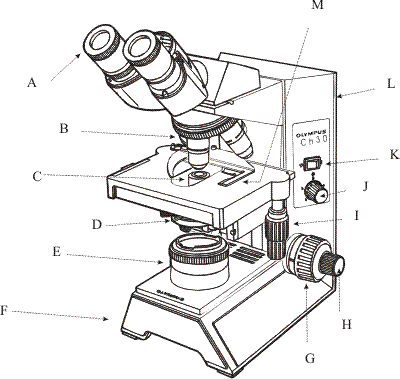
#A is the Ocular
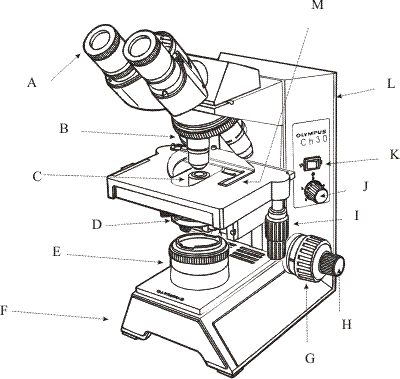
#B is the rotating nosepiece
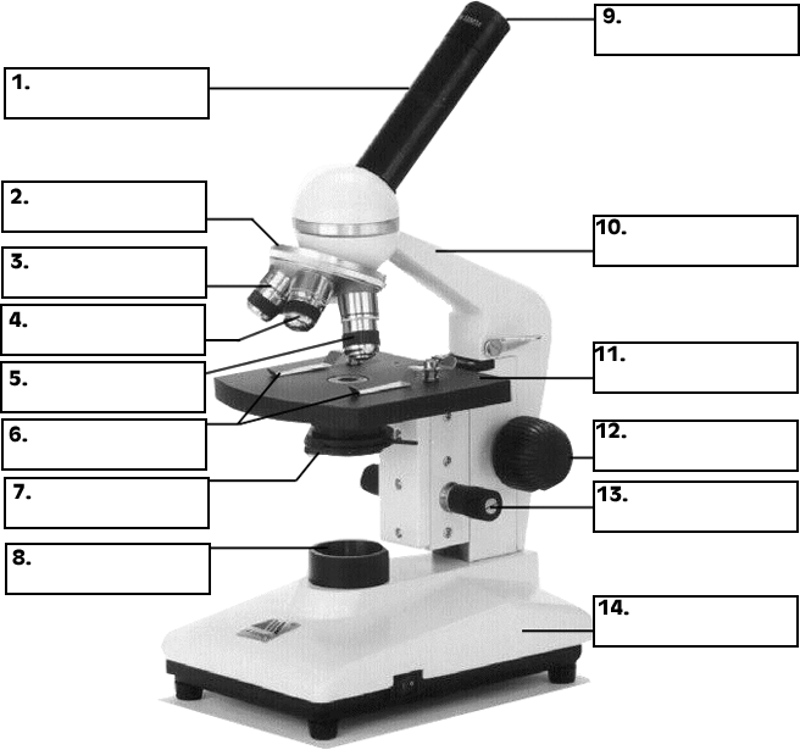
# 3, 4, 5 are the objectives
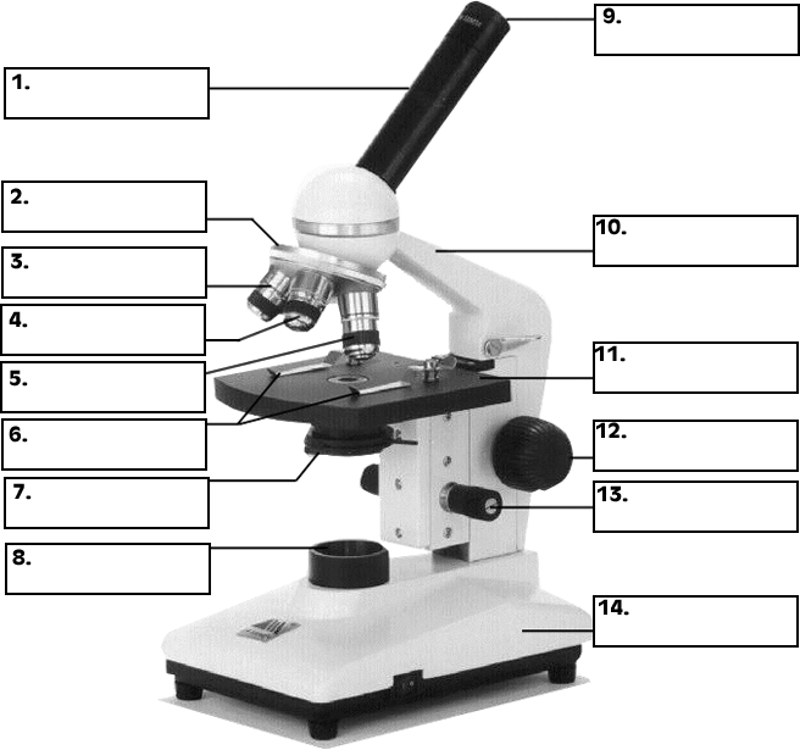
#11 is the mechanical stage

#I is the stage adjustment knobs
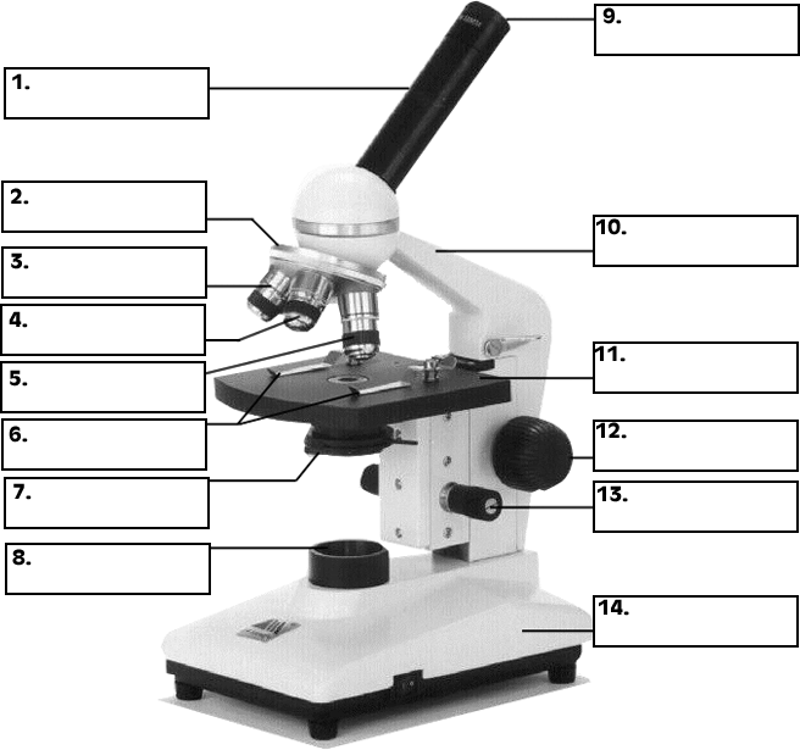
#8 is the Substage light
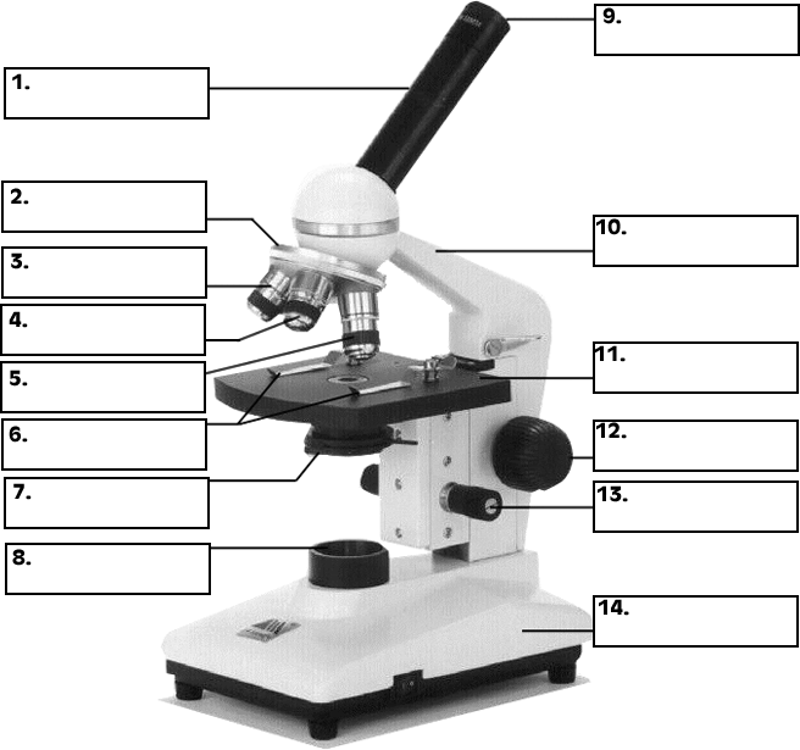
#14 is the Base
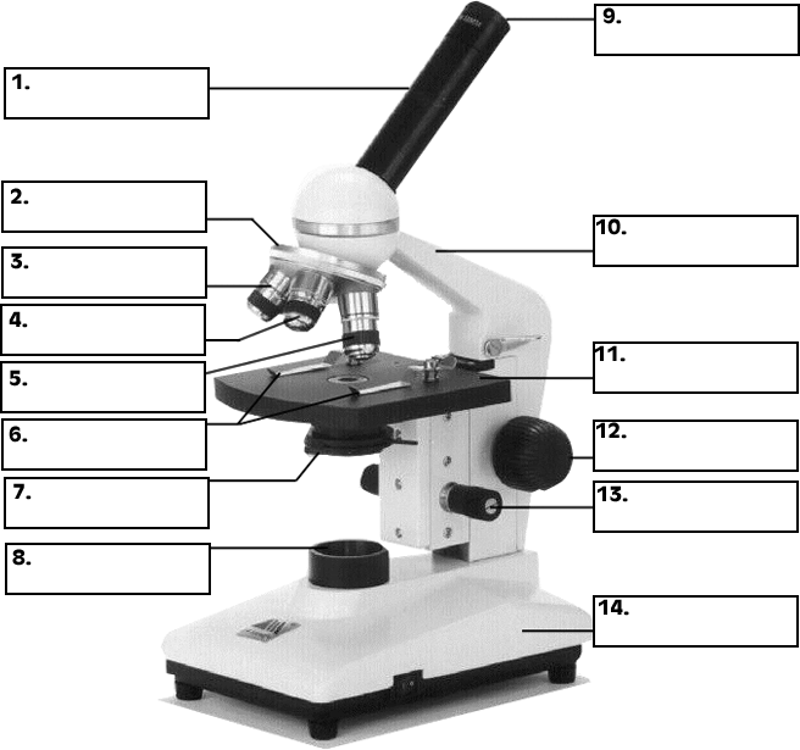
#10 is the Arm
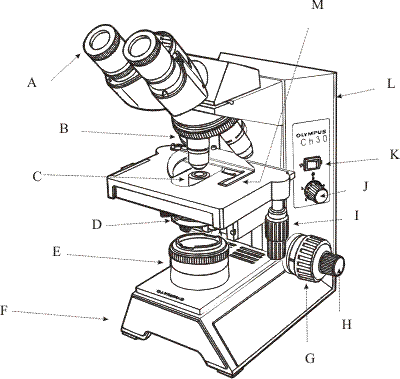
#G is the Coarse adjustment knob
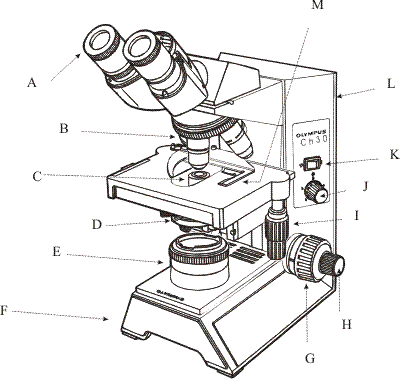
#H is the Fine adjustment knob
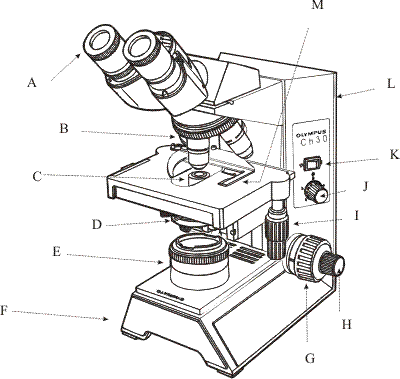
#K is the power switch
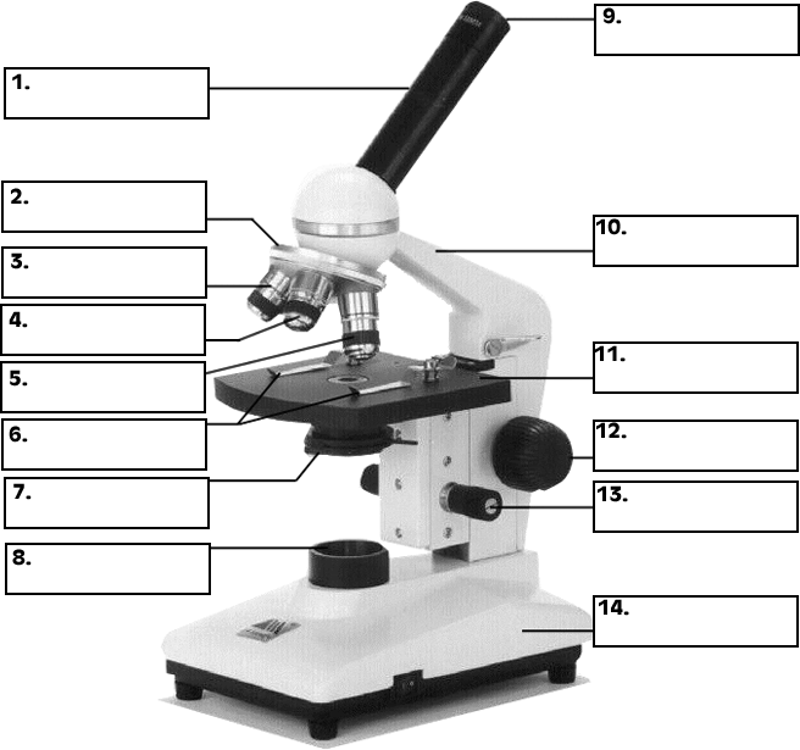
#7 Condenser
- Connected to the condenser is the iris diaphragm lever which controls the light that filters through
Working distance
The distance between the slide and the objective lens
Calculating total magnification:
Ocular 10X 10X 10X 10X
Objective (4X) (10X) (40X) (100X)
Total: 40X 100X 400X 1000X
Refraction:
The bending of light as it passes from one medium to the next
- The amount of available light decreases w/ magnification because the field of view becomes smaller and smaller
- At 1000X, there is not enough light available to see the specimen clearly w/o the use of immersion oil. Therefore, immersion oil must be used w/ the 100X objective
what happens to the field of view as the magnification increases?
it decreases
What happens to the light when the iris diaphragm lever is moved to the left (increases or decreases)? Moved to the right (increases or decreases)?
Increases, Decreaes
What happens to the contrast when the iris diaphragm lever is moved the left (increases or decreases)? Moved to the right (increases or decreases)?
Decreases, Increases
True/False:
The Coarse adjustment knob may be used with all 4 objective lenses.
False
True/False:
The fine adjustment knob may be used with all 4 objective lenses
True
What part of the microscope should be used to center the speciment in the field of view?
Stage adjustment knobs
What part of the microscope can be adjustment to increase or decrease the contrast?
iris diaphragm lever
True/False:
Immersion oil helps to increase the refraction of light as it passes through the glass specimen slide
False
If the power of the ocular is 5X and the total magnification is 200X, what is the power f the objective? Justify your answer by showing your work.
200/5 = 40
40X
If the power of the ovular is 10X and the power of the objective lens is 45X, what is the total magnification? Justify your answer by showing your work
45X*10X=450X
